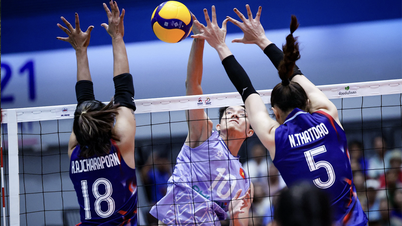Try interval walking
Based on intermittent bouts of fast and slow walking, Japanese-style walking was developed by Professor Hiroshi Nose and Associate Professor Shizue Masuki at Shinshu University in Matsumoto, Japan. It involves alternating between three minutes of walking at a higher intensity and three minutes at a lower intensity, repeated for at least 30 minutes, four times a week.
According to The Independent , higher intensity walking should be done at a slightly strenuous level. At this level, you should still be able to talk, but it will be harder to maintain a full conversation.

Japanese-style walking involves alternating between 3 minutes of walking at a higher intensity and 3 minutes at a lower intensity (Photo illustration: WP).
Interval walking training has been scientifically proven to be a simple way to safely increase intensity and provide significant health benefits.
Unlike high-intensity interval training, interval walking is a form of interval training suitable for all ages and fitness levels.
“In studies of the benefits of interval training, scientists have found improved fitness, muscle strength, and blood sugar control,” Sarah F. Eby, MD, PhD, associate professor of sports medicine at the Mass General Brigham and Women's Sports Medicine Center and a specialist in physical therapy and rehabilitation at Harvard Medical School, told Healthline .
Additionally, interval walking is a great way to meet the recommended 150 minutes of moderate-intensity aerobic activity per week.
The Difference Between High Intensity Interval Training and Interval Walking
High-intensity interval training involves alternating between periods of low-intensity exercise (or rest) and periods of high-intensity exercise. Intensity is often measured by heart rate or subjective measures such as rate of perceived exertion (RPE).
By increasing the intensity, you can achieve the same health benefits with less time in the gym. They are generally considered safe, however, some studies have shown that high-intensity interval training can lead to exercise-related injuries.
In contrast, interval walking or Japanese-style walking is less intense and is generally considered safe.
According to the original study on Japanese-style walking published in Mayo Clinic Proceedings in 2009, the standard interval walking protocol includes alternating periods of:
- 3 minutes of brisk walking (about 70% of maximum aerobic capacity, exercise level).
- 3 minutes of slow walking (40% of maximum aerobic capacity).
The recommended minimum amount of time is 30 minutes of walking 5 days a week.
Japanese researchers recruited more than 200 adults with an average age of 63 to test how effective interval walking was compared to traditional continuous-intensity walking.
They found that interval walking was superior to traditional walking in improving a variety of health markers, including blood pressure, blood sugar, body mass index (BMI), aerobic capacity, and strength (an indicator of stability and balance).
A follow-up analysis showed that 783 of the 826 subjects were able to adhere to the interval walking protocol throughout the study period, a compliance rate of 95%.
A 2024 review of interval walking concluded that its health benefits were well established in both healthy middle-aged and older adults and in people with metabolic diseases.
“Compared to continuous walking exercise and energy expenditure, interval walking is superior in improving fitness, body composition, and glycemic control in people with type 2 diabetes,” Kristian Karstoft, MD, PhD, first author of the review, Bispebjerg and Frederiksberg Hospital, University of Copenhagen, told Healthline .
Start with Japanese walking
No matter what your fitness level or goals are, Japanese walking can be a great way to start a new exercise regimen or take it to the next level.
It is also important to practice interval walking properly and you should consult your doctor before doing so.
“I always tell my patients to make sure you feel comfortable exercising. What you don’t want to do is start exercising too hard and too intensely,” says Denice Ichinoe, MD, PhD, associate professor of medicine at the Kirk Kerkorian School of Medicine at the University of Nevada, Las Vegas.
Dr. Ichinoe suggests the following tips for getting started with Japanese-style walking:
- Start with achievable goals. If you can't work out for 30 minutes when you first start, that's okay, just choose a goal that fits your fitness level.
- Use the speaking test to check your intensity level. During periods of brisk walking, you should only be able to say a few words before catching your breath.
- Wear supportive walking shoes if they are not comfortable, you will have a hard time sticking to your routine.
- Know your body, if you feel pain or dizziness, slow down or stop.
- Track your workouts with a log or fitness tracker.
Eby recommends doing a short run first. If you want to start an interval walking program, start low and work your way up.
Try walking at a normal pace for a few minutes, then walking briskly for 20-30 seconds and repeating for the duration of your walk. As your body adjusts to this new exercise stimulus, you can gradually increase the length of your brisk walking time.
Source: https://dantri.com.vn/suc-khoe/di-bo-kieu-nhat-chi-30-phut-mang-lai-hieu-qua-khong-ngo-20250618154322900.htm


































































































Comment (0)